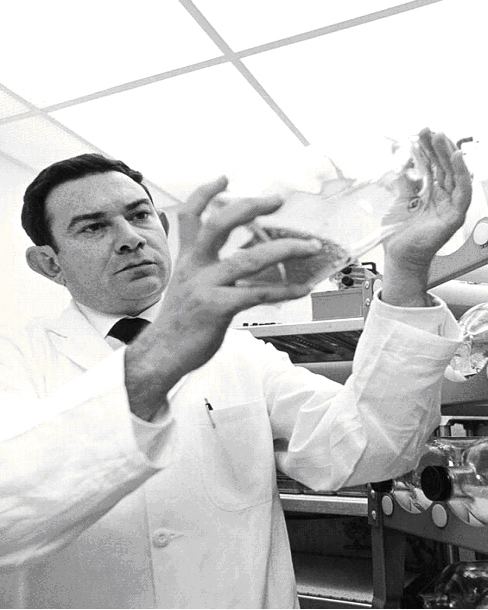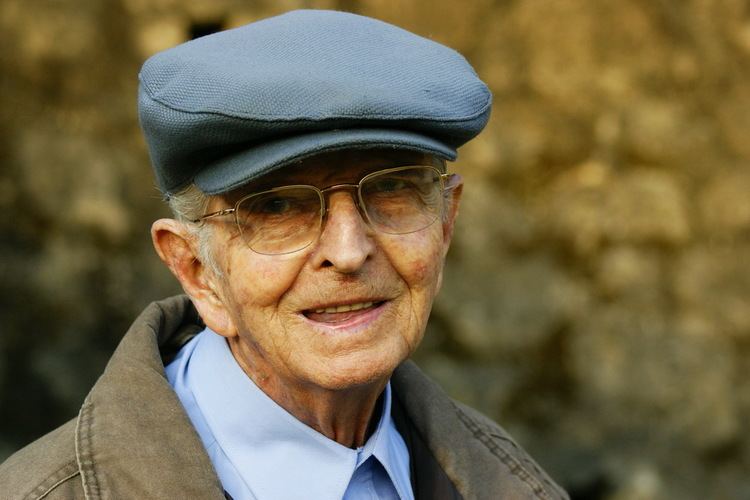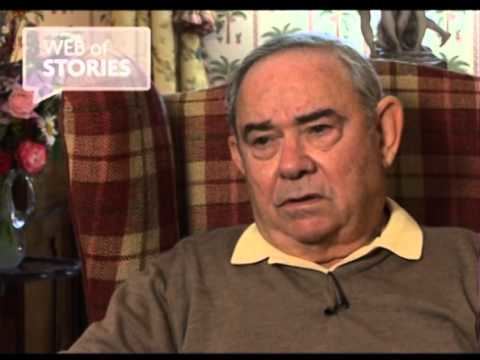Name Leonard Hayflick | ||
 | ||
Books Cell senescence and cell differentiation in vitro | ||
Dr leonard hayflick gives 10 annual hayflick lecture at uab at 50 anniversery of his discovery
Leonard Hayflick (born 20 May 1928 in Philadelphia, Pennsylvania) is a Professor of Anatomy at the UCSF School of Medicine, and was Professor of Medical Microbiology at Stanford University School of Medicine. He is a past president of the Gerontological Society of America and was a founding member of the council of the National Institute on Aging (NIA). The recipient of several research prizes and awards, including the 1991 Sandoz Prize for Gerontological Research, he has studied the aging process for more than thirty years. He is known for discovering that human cells divide for a limited number of times in vitro (refuting the contention by Alexis Carrel that normal body cells are immortal). This is known as the Hayflick limit.
Contents
- Dr leonard hayflick gives 10 annual hayflick lecture at uab at 50 anniversery of his discovery
- Background
- Research details
- References

Hayflick is the author of the book, “How and Why We Age”, published in August 1994 by Ballantine Books, NYC and available in 1996 as a paperback. This book has been translated into nine languages and is published in Brazil, the Czech Republic, Germany, Hungary, Israel, Japan, Poland, Russia, and Spain. It was a selection of The Book of the Month Club and has sold over 50,000 copies worldwide.

Hayflick and his associates have vehemently condemned "anti-aging medicine" and criticized organizations such as the American Academy of Anti-Aging Medicine. Hayflick has written numerous articles criticizing both the feasibility and desirability of human life extension, which have provoked responses critical of his views.

Dr leonard hayflick gives 10 annual hayflick lecture at uab at 50 anniversery of his discovery
Background

Leonard Hayflick was born 20 May 1928 in Philadelphia, Pennsylvania. He received his Ph.D. at the University of Pennsylvania in 1956. After receiving a post-doctoral Fellowship for study at the University of Texas Medical Branch in Galveston, under the tutelage of the renowned cell culturist Prof. Charles M. Pomerat, he returned to Philadelphia, where he spent ten years as an Associate Member of the Wistar Institute and two years as an Assistant Professor of Research Medicine at the University of Pennsylvania.

In 1968, Hayflick was appointed Professor of Medical Microbiology at the Stanford University School of Medicine, Stanford, California. Hayflick resigned from Stanford in 1976 while he was the subject of an inquiry by Stanford into his professional conduct, an episode that he characterized as "Gestapo-like" and that was later condemned by 85 prominent biologists who viewed him as having been "exonerated" by subsequent events. In 1982 he moved to the University of Florida, Gainesville, where he became Director of the Center for Gerontological Studies and Professor of Zoology in the College of Liberal Arts and Sciences and Professor of Microbiology and Immunology in the College of Medicine.

In 1988 Hayflick joined the faculty of the University of California, San Francisco, where he is currently Professor of Anatomy. Hayflick is a member of numerous national and international scientific and public boards of directors and committees. He is now, or has been, on the Editorial Boards of more than ten professional journals. Hayflick was Editor-in-Chief of the international journal “Experimental Gerontology” for 13 years.
He is a member of twenty scientific and professional societies in which he has held several high offices including President of the Gerontological Society of America from 1982 to 1983. He was a founding member of the Council of the National Institute on Aging, NIH and Chairman of its Executive Committee. He was a consultant to the National Cancer Institute and the World Health Organization, and is now a member of several scientific advisory boards. He was Chairman of the Scientific Review Board of the American Federation for Aging Research where he was also a vice president and a Member of the Board of Directors. He was also recruited by Michael D. West, founder of Geron (NASDAQ: GERN) and current CEO of BioTime, to join the company's Scientific and Clinical Advisory Board, on which he served from 1991-2000.
Hayflick is also one of several prominent biologists featured in the 1995 science documentary Death by Design/The Life and Times of Life and Times.
Research details
Hayflick is known for his research in cell biology, virus vaccine development, and mycoplasmology. In 1962 he discovered that, contrary to the belief prevalent at the turn of the century, cultured normal human and animal cells have a limited capacity for replication. This discovery, known as the Hayflick limit, overturned a dogma that existed since Alexis Carrel's work early in this century that claimed that normal cells would proliferate continuously in culture. Hayflick's results focused attention on the finite cellular life-span was the fundamental location of age changes and that immortality was a key feature of tumor cells. Hayflick demonstrated for the first time that mortal (normal) and immortal (malignant) mammalian cells existed.
Hayflick developed the first normal human diploid cell strains for studies on human aging and for research use throughout the world. Before his seminal research all cultured cell lines were immortal and aneuploid. One such cell strain, developed by Hayflick and his colleague Paul Moorehead at the Wistar Institute in Philadelphia, Pennsylvania, called WI-38, was the most widely used and highly characterized normal human cell population in the world. Hayflick produced the first oral polio vaccine made on a continuously propagated cell strain. WI-38 is now used for the production of all of the Rubella Virus vaccine used in the Western Hemisphere. WI-38, or new diploid cell strains, is used today for the manufacture of most human virus vaccines produced throughout the world including those for poliomyelitis, rubella, rubeola, varicella, mumps, rabies, adenoviruses and hepatitis A. Over one billion vaccinees have received vaccines produced on WI-38 or foreign version of Hayflick's original WI-38.
Hayflick is also known for his discovery of the cause of primary atypical pneumonia (“walking pneumonia”) in humans. The etiological agent was first thought to be a virus, but Hayflick showed that it was, in fact, a mycoplasma, a member of the smallest free-living class of microorganisms. The etiological agent was named by him as Mycoplasma pneumoniae, and was first grown by Hayflick on a medium he developed and that bears his name. It is now used worldwide for mycoplasma isolation and research.
Hayflick is the recipient of more than twenty-five major awards including the $20,000 Brookdale Award and the Kleemeier Award from the Gerontological Society of America, the Biomedical Sciences and Aging Award from the University of Southern California, The Karl August Forster Lectureship of the Academy of Sciences and Literature and the University of Mainz, Germany, the Samuel Roberts Noble Foundation Research Recognition Award, the Lifetime Achievement Award of the Society for In Vitro Biology, the Sandoz Prize from the International Association of Gerontology, and the Presidential Award from The International Organization for Mycoplasmology. Hayflick, together with Paul Moorhead, has been awarded the prestigious John Scott Award for 2014.
In the mid-1990s, Hayflick was recruited by Geron founder Michael D. West to join the company's Scientific Advisory Board. In 1997, Hayflick was elected Academician and Foreign Member of the Ukrainian Academy of Medical Sciences. In 1998 he was elected corresponding member of the Société de Biologie of France. In 1999, he was presented with the van Weezel Award by the European Society for Animal Cell Technology and the Lord Cohen of Birkenhead Medal by the British Society for Research on Ageing. In 1997 the American Aging Association established an Annual Hayflick Lectureship. In 2000 a second Annual Hayflick Lecture also was established by the University of Alabama, Birmingham. Hayflick is the recipient of the year 2001, $10,000 Life Extension Prize and Laureate Diploma from the Regenerative Medicine Secretariat for his "... discovery of the finite replicative capacity of normal human diploid cells ..."
Hayflick is a Fellow of the American Association for the Advancement of Science, an Honorary Member of the Tissue Culture Association and, according to the Institute of Scientific Information, is one of the most cited contemporary scientists in the world in the fields of biochemistry, biophysics, cell biology, enzymology, genetics and molecular biology. Hayflick is the author of over 275 scientific papers, book chapters and edited books of which four papers are among the 100 most cited scientific papers of the two million papers published in the basic biomedical sciences from 1961 to 1978.
The inverted microscope that Hayflick modified for use in his tissue culture and mycoplasma work and on which all other such microscopes have been modeled has been acquired by the Smithsonian National Museum of American History.
